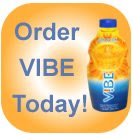 Antioxidants act as cell protectors, and are believed to help protect the body from free-radical damage. In order to fully understand this mechanism we would need a brief refresher course in Physiology/Chemistry 101 ... well skip that here :-).
Antioxidants act as cell protectors, and are believed to help protect the body from free-radical damage. In order to fully understand this mechanism we would need a brief refresher course in Physiology/Chemistry 101 ... well skip that here :-).Just to sum it up, antioxidants help to prevent cell tissue damage that has been linked to disease and aging. They do this by donating one of their own electrons to neutralize damage to cells by free radicals. This ends the electron-stealing reaction because antioxidants themselves are stable with or without this electron.
Eating a balanced diet and getting 5-8 servings of fruits and vegetables per day is an excellent start to ensure an adequate intake of antioxidants. A few of the better-known antioxidants include carotenoids--the substance that gives fruits and vegetables their deep rich colors. Apricots, broccoli, pumpkin, cantaloupes, spinach, carrots, red bell peppers, and sweet potatoes, are some good choices in addition to lycopene in tomatoes.
Other examples of antioxidants include, Vitamin C, E, A (which is converted from beta-carotene), and selenium (a mineral).
Vitamin C - The most abundant water-soluble antioxidant in the body. Acts primarily in cellular fluid. It also helps return vitamin E to its active form. Present in citrus fruits and juices, green peppers, cabbage, spinach, broccoli, kale, cantaloupe, kiwi, and strawberries.
Vitamin E - d-alpha tocopherol. The most abundant fat-soluble antioxidant in the body.Primary defender against oxidation. Present in nuts, seeds, vegetable and fish oils, whole grains (esp. wheat germ), fortified cereals, and apricots.
Vitamin A - (Beta-carotene is converted to vitamin A (retinol) by the body) The body will only convert as much vitamin A from beta-carotene that it needs, which makes this a safe source of vitamin A. However, be careful of supplementing with Vitamin A. Too much via supplementation can be toxic.
Selenium - A trace mineral and a proven antioxidant. The most concentrated food source is in the Brazil nut, which contains about 120 mcg. Seafood and poultry are also good sources, as are grains…especially oats and brown rice. But the amount of selenium in foods depends on how much was in the soil to begin with. With the mineral depletion in the soil today, it is unlikely that you will get too much in your food.
Adding a rich source of antioxidant foods into your diet will help protect your body from the long-term and cumulative effects of free radical damage. Antioxidants have been shown to protect the body from diseases like cancer, heart disease, stroke, and Alzheimer's disease.
Vibe has one of the highest antioxidant ratings in the industry!
To learn about Vibe & begin your journey to health click here!
Have questions or want to purchase Vibe? Just call me, (Darlene) at 502-363-0101 and I'll see that you get Vibe at the lowest possible price, just $39.95 per bottle.



No comments:
Post a Comment